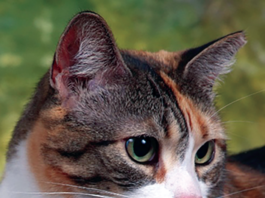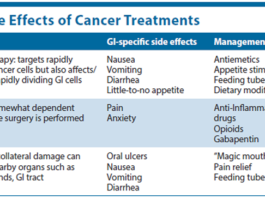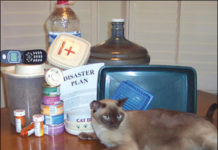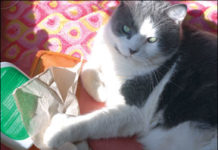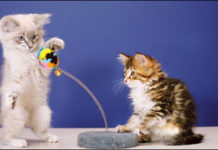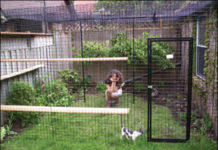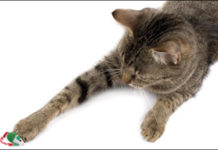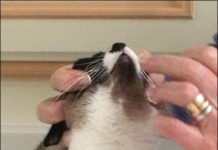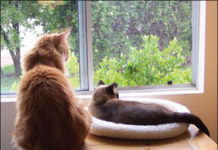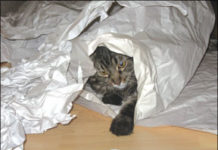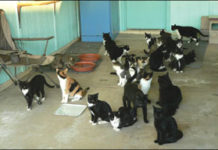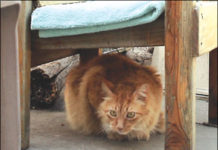Pet Owner Fire Safety Tips
When an out-of-control firestorm raced through the hills above Santa Barbara, California, last fall, frantic residents had little time to grab a few belongings and flee. "My wife and I were able to safely evacuate with our dogs and one of our cats," remembers Jason Bryan, a resident of Montecito, a tiny enclave of Santa Barbara. "Unfortunately, our other cat, Sunny, is adept at hiding, and we couldnt find him before we had to leave. For days, the Bryans lived in a cramped motel room and were forced to wait and wonder whether their house - and beloved cat - had survived the flames. On the fourth day, they were allowed to return to their burned out neighborhood. "Miraculously, our house was still standing," says Marian, Jasons wife. "And best of all, we found Sunny inside, hungry and lonely, but alive. We feel truly blessed." Some were not as fortunate as the Bryans. Sabrina Robinson was just finishing up her workday at a medical supply company when the fire broke out shortly before 6:00 pm on that fateful day. She wasnt aware of the imminent danger until she stepped outside and smelled the acrid smell of smoke.
Cleaning Naturally
The cleanser you scrubbed your counter with makes your kitchen smell fresh and clean. It also makes it into a hazardous waste site for your cat. Common household cleaners carry labels warning of their dangers, and so most people use gloves or wash their hands after using them. But every time your cat walks across a newly cleaned counter or floor and then grooms itself, it ingests the cleaning product. Even if you rinse and dry the area, some residue can remain. Cleansers such as Lysol contain phenols and alcohol, both of which are toxic to cats and can cause digestive upset and irritations in the mouth. Bleach, a popular cleaning product, will cause skin irritation; when combined with ammonia, it forms poisonous chlorine gas. Any product containing pine oils, such as Pine Sol, can cause liver damage. Some vets say theyve never seen an example of cleanser-caused toxicity in cats. But we know from human studies that the effects of environmental toxins are not always obvious. Rather than risk skin irritation or liver failure, why not use natural cleansers that are safe for pets and humans? And theres no need to spend a fortune on fancy "green" products, either. Your kitchen cupboard probably has all the cleaning power youll need to keep your home sparkling.
Entertain Your New Kitten!
Perhaps the most endearing characteristic about kittens is their propensity for play; every kitten seems to be hard-wired to appear especially cute and to play unabashedly. It isnt until youve been awakened at midnight with little kitty claws batting at your toes, however, that you begin to realize the very real need kittens have for play. Its not just something they do to fill the time; they will set their alarms two hours early to ensure that they have plenty of play practice time! And, just like any small child, if a kitten is not given plenty of appropriate ways to play, he will find even more inappropriate ways. Dr. Julia Albright, Resident in Animal Behavior at Cornell Universitys College of Veterinary Medicine, explains why play is essential for kittens. "It provides social interaction, exercise and appropriate expenditure of energy. Cats are very good at finding inappropriate means of expending exuberance (i.e. attacking your leg!) if not given object play. It also allows them to learn bite inhibition; orphaned kittens are often very aggressive and bite very hard as adults." Dr. Albright relates that, "Play involves components of adult behavior such as hunting (stalking, pouncing, biting, etc.) and is hypothesized to be practicing of these skills." So it is extremely important to provide appropriate outlets for a kittens seemingly endless desire to play if you want a well-adjusted addition to your family.
Create An Outdoor Enclosure For Your Cats
Some cats seem to pine for sunshine and fresh air, despite all the arguments in favor of keeping cats indoors. Cat enclosures are the perfect way to give cats access to the outdoors without compromising their safety. In an enclosure, your cat wont be able to wander away and get in trouble with cars or the neighbors. An enclosure with a roof is far safer than a fenced-in yard, because although fences can be adapted to keep cats in, they wont necessarily keep other animals out. But in an enclosure your cat will be able to enjoy the sunshine and youll be able to relax, knowing your cat is safe inside. Everything from small, pre-fabricated enclosures perfect for limited yard space to giant, custom-built models that enclose entire yards can be bought on-line. Or use your own imagination to create an outdoor play space for your cat, attached to your house or free-standing. Dont neglect vertical space in your design; cats love to go up as much as they love to explore the ground. When building your own enclosure, use only sturdy materials that your cat cant destroy and that wont degrade too quickly from exposure to weather. Plan your design carefully; as the saying goes, measure twice and cut once. Dont forget to include an opening big enough for you in the design - youll need access, too. Youll probably want to add a lock to this human-sized door, to discourage unwanted entry.
Help for the Choking Cat
Cats are known to be fastidiously discriminating in their eating behavior. Compared to dogs, they are extremely cautious about what they take into their mouths. Owing to their finicky habits, a cat is unlikely to ingest anything that could cause it to choke. But accidents do happen. A cats environment is full of countless little objects, from sticks, stones and rodent bones - to thimbles, buttons, rubber bands and strands of yarn. If a cat inadvertently takes such a foreign object into its mouth, is not immediately able to disgorge it and attempts to swallow it, the animals upper respiratory apparatus can become blocked and its oxygen supply can become seriously diminished or totally impeded. Oxygen deprivation can cause death within a matter of minutes. Therefore, any signs of choking must be viewed as an emergency situation requiring immediate attention. However, says Gretchen Schoeffler, DVM, chief of emergency and critical care services at the Cornell University Hospital for Animals, veterinarians rarely treat cases of feline choking. This is because such traumatic events tend to be either (1) self-limiting; (2) relieved thanks to prompt action by an affected animals owner; or (3) fatal before veterinary help can be obtained.
Medicating Your Cat
For many pet owners, the realization that a cat will require medicating - even for just a few days - is enough to cause serious apprehension. Though some felines are extraordinarily good when it comes taking their medicine, others are not. Cats can be notoriously difficult to capture, restrain and medicate; however, with the following expert tips, medicating a cat can be much less stressful - for both cat and owner. "One of the biggest stumbling blocks for cat owners is the mindset with which they approach medicating their cats," explains Jodi Korich, DVM, the director of Partners in Animal Health at Cornell Universitys College of Veterinary Medicine. If you are nervous about medicating your cat or perhaps youre feeling incredibly worried because your kitty is ill, your cat will pick up on this. "You have to approach medicating your cat with the mindset that you are doing this for the cats own good, working calmly, quickly and not obsessing over the process," recommends Dr. Korich. A positive, confident approach may make your cat feel more secure.
Foreclosures: Cats in Peril
With the numbers of foreclosures rising on a daily basis in some areas of the country, realtors and foreclosed-property inspectors relate that they are making an alarming discovery: Pets have been found locked in the home without food or water, abandoned in the streets or let loose in yards. It is obvious that foreclosures are not just affecting people; they are also affecting the pets of evicted families. With an estimated 34 percent of all home owners owning one or more cats (2007 AVMA US Pet Ownership and Demographics Sourcebook), and more than 1.6 million foreclosures recorded in the month of December 2008 alone, the potential for displaced cats is enormous. Just how many cats are being affected by foreclosures is more elusive than estimating the impact on pet dogs, notes Janet Scarlett DVM, MPH, PhD, professor of Epidemiology and director of Maddie's Shelter Medicine Program at Cornell Universitys College of Veterinary Medicine. A dog that is left behind is usually spotted and found. "A cat that has been put in the yard isnt going to be found by a realtor. For that reason, its much harder to measure the problem accurately," she notes. Recent intake numbers (the number of surrendered, stray or abandoned pets that are taken into a shelter) from areas hardest hit economically support the theory that many pets, including cats, are suffering from the first wave of foreclosures. For example, the Los Angeles Animal Services experienced a 20 percent increase in intake numbers in 2008. One Atlanta, GA shelter reported a 71 percent increase in intake numbers last year; and, a shelter in Fulton County, GA tallied a 250 percent intake increase in 2008 during an eight month period (March through December).
Ten Ways to Go Green
It should come as no surprise that Mother Nature is on the verge of taking a permanent sick day. After all, harmful climate changes due to greenhouse gases, air and water pollution, and the destruction of natural habitats are putting our planet and its inhabitants - both two- and four-legged - in peril. Hopefully, many of us have begun to make some changes in our daily lives to help reverse the damage done to, well, everything. But what role can our cats play in being good stewards of our beleaguered planet? There are many practical ways to reduce your felines carbon pawprint, which include switching to a corn or wheat-based cat litter and recycling cat food containers instead of throwing them in the trash. Get a jump start on Earth Day (April 22) by incorporating the following tips into your daily routine. Start out slowly if you wish by trying one or two new tips each week. Encourage your friends, family members and co-workers to join in your quest for a sustainable future. Youll find that its not only fun and easy to "go green," but youll see that you can make a positive and lasting impact on our world, which will please Mother Nature.
Pet Care on a Budget
With the economy stumbling, the prospect of hundreds of dollars a year in cat care may seem daunting. But dont worry: There are plenty of ways to defray the cost of owning a cat without compromising your pets well-being. In fact, some of the most effective strategies will actually benefit your cat. As Jodi Korich, DVM, director of Partners in Animal Health at Cornell Universitys College of Veterinary Medicine explains, "One of the best ways to save money on your pets health is to pay attention to early disease detection and preventive health care." Just like oil changes and preventive maintenance result in fewer repair bills for your car, she says, regular check-ups and early intervention will save you money in the long run. Dental hygiene tops Dr. Korichs list of money-saving health care. Dental disease is the most common malady cats suffer, afflicting fifty percent of all cats. Learning to brush your cats teeth at home can make a tremendous difference in your cats oral health. While its not easy to become an expert at cat-brushing, it costs little and can save a lot. Early intervention is equally important. Because you know your cat better than anyone, youre in the best position to spot subtle changes that might indicate a medical problem. Dont ignore something small in the hopes that it will go away because the cost of a cure gets larger the bigger the problem gets. Make it a habit to examine your cat weekly for things like missing hair, skin bumps, tearing eyes or excessive drooling. Keep an eye out for changes in your cats routine, such as a change in appetite or bowel habits.
Obesity: A Big Problem
Feline obesity is a problem among housecats. "As many as 30 to 40 percent of cats are overweight, with 15 to 20 percent falling in the obese range," says Joseph Wakshlag, DVM, PhD, DACVN, assistant professor of clinical nutrition at Cornell Universitys College of Veterinary Medicine. Despite public education efforts by the veterinary community, the numbers have not improved over the past decade, which is especially troubling because added weight can have serious health repercussions for cats. An overweight cat is at risk for several diseases, relates Dr. Wakshlag. "Obesity is one of the biggest factors for feline diabetes II," he says, adding that the extra weight carried by heavy cats causes stress on the felines joints, which can cause early onset of arthritis. Obese cats are also at heightened risk for feline hepatic lipidosis (FHL), or feline fatty liver syndrome, a liver disease that occurs when fat cells build up in the liver and prevent it from functioning normally. Heavy cats also may have more difficulties grooming themselves, which could cause hygiene and skin issues. Overweight cats may also be at increased risks in surgery.
Spaying: Very Important
When your purebred kitten reaches maturity, you may want to breed her, and you may already have a carefully worked-out strategy for doing so. Otherwise, there is no good reason to avoid having the little animal spayed while shes still in the early months of her life - and there are a number of good reasons for doing so. First and foremost among these reasons, says Andrea Looney, DVM, a lecturer in anesthesiology at the Cornell University Hospital for Animals, is that spaying - also called ovariohysterectomy - will help curb rampant feline overpopulation. According to the American Society for the Prevention of Cruelty to Animals, millions of feral and unwanted domestic cats are born each year. They are either abandoned or relegated to frequently overcrowded shelters and a dismal existence that is often relieved only by euthanasia. Moreover, Dr. Looney points out, spaying a female kitten at four to six months of age - when her reproductive organs are nearing maturity - will dramatically reduce her susceptibility to several life-threatening disorders associated with the feline reproductive system. For example, spaying a kitten prior to her first heat - before her breast tissue develops - will virtually eliminate her risk for mammary cancer later in life. Also, since spaying entails the removal of a females uterus, Dr. Looney notes, the procedure rules out the possibility of pyometra, a potentially fatal collection of pus in that reproductive organ. Other conditions that are prevented include vaginal hyperplasia, a gross swelling of the vaginal wall that occurs during the normal heat cycle; uterine torsion, a twisting of the uterus that may occur late in pregnancy; uterine prolapse, the bulging of the uterus into the vagina; and a variety of infections, cysts and cancers of the uterus and ovaries.
Epilepsy: Always Alarming
Whether happily playing with its favorite toy, vigorously pursuing a tiny mouse, or frantically fleeing from a mean-spirited predator, all of your cats activities rely on the controlled transmission of electrical signals among the billions of nerve cells (neurons) that are jammed into its little brain. In a normal cat, the transmission - or firing - of these signals is well controlled within the central nervous system. These neurons either fire or are inhibited from firing according to an animals shifting needs and desires. In the brains of cats affected with the disorder known as epilepsy, however, this elegant process goes awry. As Alexander de Lahunta, James Law Professor Emeritus of Anatomy at the Cornell Universitys College of Veterinary Medicine, explains: "Neurons are made to fire, so until the transmission of electrical signals is needed, they are kept in a static, inhibited state. If something interferes with that inhibition, an uncontrolled firing of neurons can occur - and that is the phenomenon commonly referred to as a seizure." Dr. de Lahunta describes the "classic" seizure as follows: "The animal suddenly begins to alter its behavior. It acts warily, as if it senses that something unusual is about to happen. It gets very tense, its muscles contract, causing stiffness and trembling. It begins to chew and to drip saliva, even though there is nothing in its mouth. Then the animal becomes increasingly rigid, falls to one side with its limbs extended, and starts paddling them. "Meanwhile, the cats entire body starts shaking - and at this stage, it may stop breathing for as long as 30 or 40 seconds. And then, the panting and shaking and everything else begins to slow down - and within a few minutes, the animal seems to be normal again."



